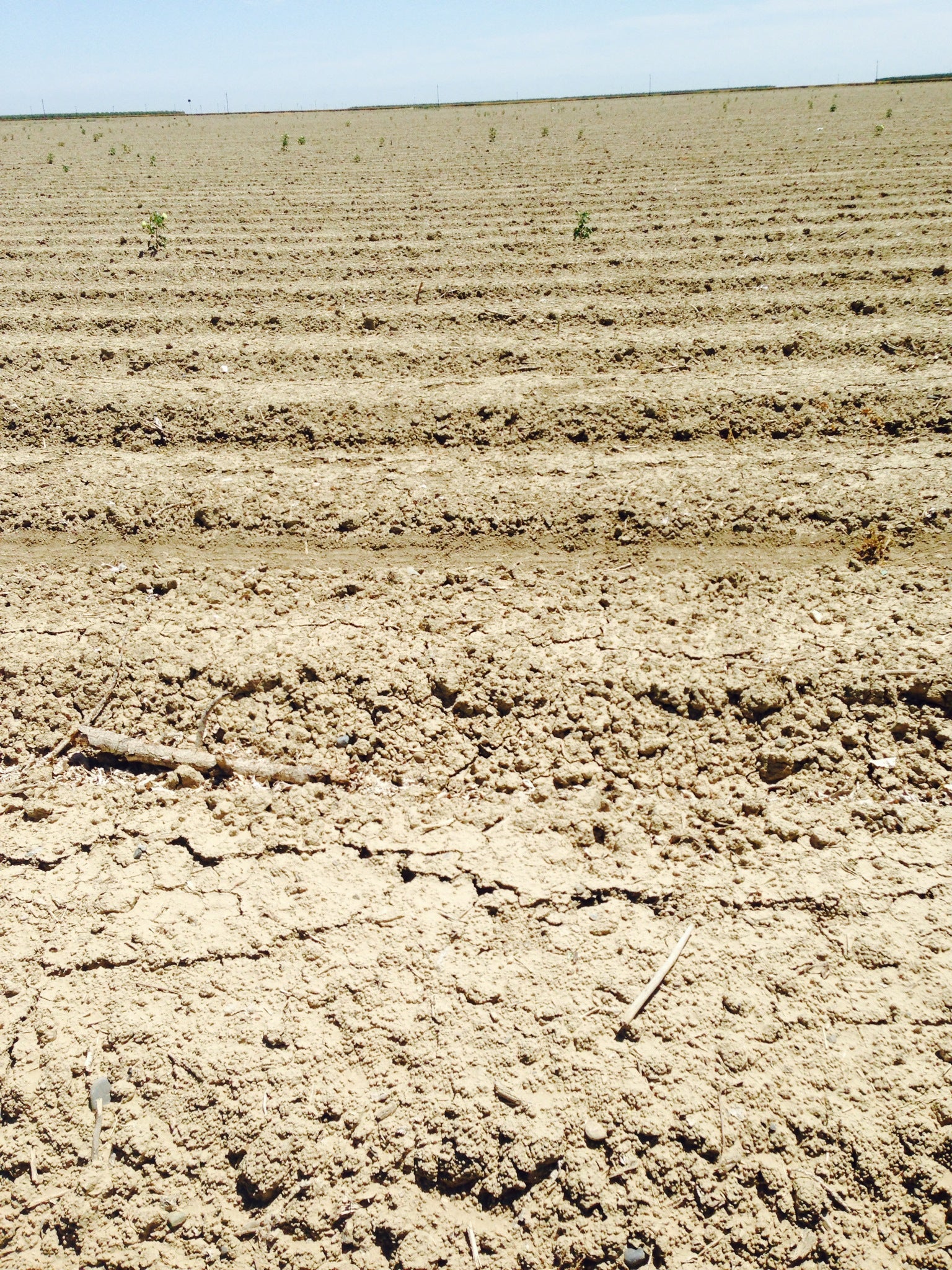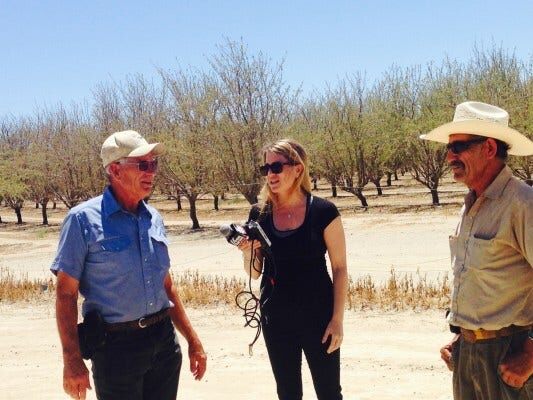Farmers of small and medium-sized operations say in California’s historic drought they feel like they’re losing two battles: One for water, and one for their reputations.
By FOX News Radio’s Jessica Rosenthal in California
The San Joaquin Valley has been called the nation’s breadbasket, but Teresa Buchanan owner of GS Farms in Cantua Creek wonders if that’s a title that can last. She now has dry cracked fields where tomatoes and cotton used to grow. “This is the first time we’ve fallowed this amount of land.” She’s fallowing just over a third of the 1,900 acres she farms after receiving zero water from the Central Valley Project, which is the agency that allocates much of the farmers’ water in this area. The Central Valley Project is run by the federal government and this year was a zero water year.
Bob Diedrich owns far fewer acres than he used to, but is still farming in a nearby town called Firebaugh. He bought additional water to help, but it will run out soon. “This year is it.” He has fallowed 70 of his 120 acres.
Todd Allen says last year he had to sell some land to pay off the mortgage on his farm. “This year, I had to fallow all my land.” 450 acres. He estimates he’s lost about a million dollars over two years, and he’s now relying on insurance.
The 2015 Drought Economic Impact Study out of UC Davis estimates that about “564,000 acres will be fallowed because of the drought, resulting in a statewide reduction in gross crop farm revenue of about $856 million”. Add on livestock and dairy losses as well as job losses and they estimate a total economic hit to agriculture of $2.7 billion.
Buchanan, Diedrich, and Allen all say all those impacts are making them angry. They’re losing acreage and yet being blamed for using 80% of the state’s available water. “How do you use 80% of zero?” Dietrich asked. That 80% number has often been cited in news reports, but it’s a number with which they argue. A spokesman with the California Department of Water Resources explains: Of developed water, or water designated for human use, farmers do use about 80%. But of all water in the state, farmers use roughly 40% and 50% is classified as designated for environmental purposes.
These particular farmers also argue that of the water they are using, little to none of it goes to waste, because they use drip irrigation. Tubes run throughout their farms, some above ground and some just below the surface, that drip or trickle out water slowly over time.
In April, California Governor Jerry Brown ordered reductions in overall water use by 25%. But that order did not pertain to Agriculture. Farmers’ water allocations are regulated, and Brown explained, “Agriculture has already suffered major cutbacks… Farmers have been hit very hard.”
The Governor’s defense though, is not enough in the minds of the farmers. They say that water designated for environmental purposes is the real problem. That too much of it is being kept in the Delta instead of being pumped south to them, specifically water kept to protect endangered fish like the Delta smelt and some Chinook salmon.
Diedrich says he understands there must be a balancing act. “Who is against saving an animal? I mean that’s the way farmers are, we take care of the ground.” They don’t deny there is a drought, but say the water that does exist has been mismanaged. Buchanan argues, “We could’ve experienced better allocation… It’s above and beyond what’s really needed for the benefit of the fish.”
Environmental groups take exception to that. Gary Bobker with the Bay Institute, a watershed and San Francisco Bay conservation group, says in the past two years no water was used to protect smelt. And this past year only about 2% of water supply has been to protect endangered fish like salmon. He says water is mainly retained for the Delta’s overall ecosystem as well as water quality for everyone. “That’s water quality for water pumped south, and water quality for farmers in the delta, and water quality for the environment.”
But according to the state Department of Water Resources, chief hydrologist Maury Roos, fishery rules from the State Water Project did cost contractors 90,000 acre feet from December through February, which they might have been able to pump but stayed in the Delta. (Three acre feet is roughly a million gallons.) Roos explains that given the amount of water they plan to release this year, 90,000 acre feet would amount to 11%. The farmers we spoke with for this article get water from the Central Valley Project.
Paul Fujitani, an engineer with the Bureau of Reclamation which runs the Central Valley Project says water is designated for fishery purposes every day. He could not provide a percentage but stated “We provide fish releases every day of the year…Our state water requirements include releases and operations for protecting fish. Delta smelt and Chinook included.”
Teresa Buchanan says when it comes to retaining water in the Delta for its quality Delta managers are keeping way too much fresh water in order to keep salt water from the Pacific Ocean out. But Bobker with the Bay Institute says farmers need that saltwater kept out of freshwater as much as fish do. “The water that goes through the system is keeping the water clean, so you’re getting fresh water. It’s moving nutrients and fish out from the upper part of the system down, that’s how salmon make it to the ocean. It’s maintaining a salt/freshwater interface.”
Bobker says better management of groundwater is what’s needed. Surface water is what farmers get released from reservoirs, but due to the drought they’re not getting much of that. So they’ve been turning to groundwater – water underground they must access through wells. Buchanan has multiple wells on her property. And before he gives up entirely, Allen says he will drill a well on his property.
“Before you know it they’re going to start regulating our groundwater. I’m putting a well in. I’m making a big commitment. I don’t even know what kind of quality water I’m going to get.”
But this is the fourth year of the drought and groundwater is already being depleted at an alarming rate.
According to a 2014 report from the California Department of Water Resources since spring 2008, groundwater levels are at all-time historic lows in most areas especially in the southern San Joaquin Valley. Where Diedrich, Allen, and Buchanan all farm. The report states: “There are many areas of the San Joaquin Valley where recent groundwater levels are more than 100 feet below previous historic lows.” So much is being pumped scientists say the ground is actually sinking.
Last year Governor Jerry Brown signed three groundwater management bills. But Allen has several years before he has to worry about enforced groundwater management. Lauren Bisnett with the state Department of Water Resources Sustainable Groundwater Management program says they are gathering up information on groundwater basin boundaries across the state now. But local agencies don’t have to adopt groundwater sustainability plans until January 31, 2022. “Limitations on groundwater use probably won’t come until 2040 which is when groundwater sustainability needs to be achieved,” according to Bisnett.
Finally, some farmers feel they are being blamed over the kinds of crops they choose to grow. Almond farmers say they’re taking a lot of heat because of how much water almonds use. It takes .7 to 1.1 gallons per nut. Teresa Buchanan says without her almond trees she’d be in financial trouble. But Bobker with the Bay Insitute points out trees are the last to be fallowed. They’re an investment since they’re already planted and living. Fallowing a field used to grow tomatoes is a lot easier than ripping out trees, and a lot less expensive.
Governor Brown has said he will not tell farmers what to grow.
For some like Allen and Diedrich the solution may be to walk away. “If I can find someone to buy ‘em I might just sell,” says Diedrich. “There’s a few big investment companies that are coming in and buying these orchards. Where they’re getting water I have no idea.” When it comes to his land though he says he doubts anyone would buy… Not without a good water source on which to rely.
LISTEN for more on the California drought from FOX News Radio’s Jessica Rosenthal:








